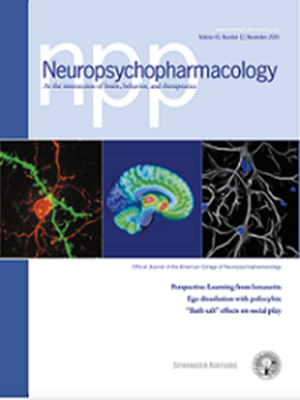中央执行网络驱动δ -9-四氢大麻酚(THC)诱导的青少年非人灵长类动物大规模功能连接的非线性变化。
IF 6.6
1区 医学
Q1 NEUROSCIENCES
引用次数: 0
摘要
青少年大麻素暴露与成人大脑回路的持久改变有关;然而,长期暴露于德尔塔-9-四氢大麻酚(THC)对大脑连通性的剂量依赖性影响缺乏良好控制的系统分析。假设大规模的内在网络,如默认模式(DMN)、中央执行网络(CEN)和突出网络(SN),在青少年大麻使用相关的认知处理缺陷的脆弱性中起关键作用。本研究旨在阐明慢性四氢大麻酚暴露对非人灵长类动物这些假定的大规模网络的功能连接(FC)的影响。将青春期松鼠猴(雌性为2.0岁,雄性为2.5岁)分为两组,在青春期连续6个月每天肌肉注射四氢大麻酚或载药(0.32或3.2mg/kg)。在给药前、慢性给药6个月时和停止每日四氢大麻酚暴露后60天,对清醒受试者进行静息状态功能连通性扫描。利用两种不同的分析方法,我们观察到DMN-CEN FC在扫描间隔中的非线性剂量依赖性变化。具体而言,与给药前和停药期间相比,慢性暴露期间暴露于低THC剂量会增加FC。然而,在载药组或高THC剂量组均未观察到这种模式。双回归揭示了CEN中类似的非线性效应,但DMN中没有,这表明对DMN-CEN FC的影响可能是由CEN内部的变化驱动的。综上所述,这些结果表明,青少年四氢大麻酚暴露对大规模大脑网络的影响不同,有助于细致入微地了解慢性四氢大麻酚暴露后CEN在破坏大脑连接方面的作用。本文章由计算机程序翻译,如有差异,请以英文原文为准。

Central Executive Network drives delta-9-tetrahydrocannabinol (THC)-induced nonlinear changes in large-scale functional connectivity in adolescent nonhuman primates
Adolescent cannabinoid exposure has been implicated in enduring modifications to adult brain circuitry; however, well-controlled, systematic analyses investigating dose-dependent effects of chronic delta-9-tetrahydrocannabinol (THC) exposure on brain connectivity are lacking. It is hypothesized that large-scale intrinsic networks, such as default mode (DMN), central executive (CEN), and salience networks (SN), are critically involved in vulnerability to deficits in cognitive processing often associated with adolescent cannabis use. The present study aimed to elucidate the effects of chronic THC exposure on functional connectivity (FC) of these putative large-scale networks in nonhuman primates. Separate groups of adolescent squirrel monkeys (aged 2.0-yrs [female] and 2.5-yrs [male]) were administered intramuscular injections of vehicle or THC daily (0.32 or 3.2mg/kg) for 6-months during adolescence. Resting state functional connectivity from scans conducted in awake subjects was measured before dosing, at 6-months of chronic dosing, and 60-days following discontinuation of daily THC exposure. Utilizing two distinct analytical methodologies, we observed a non-linear, dosage-dependent alteration in DMN-CEN FC across scan intervals. Specifically, exposure to a low THC dosage increased FC during chronic exposure compared to both the pre-dosing and discontinuation periods. This pattern, however, was not observed in either the vehicle or high THC dosage groups. Dual-regression unveiled a similar non-linear effect within the CEN, but not DMN, suggesting the effect on DMN-CEN FC may be driven by modifications within the CEN. Taken together, these results suggest adolescent THC exposure differentially affects large-scale brain networks and contributes to a nuanced understanding of CEN’s role in disrupting brain connectivity following chronic THC exposure.
求助全文
通过发布文献求助,成功后即可免费获取论文全文。
去求助
来源期刊

Neuropsychopharmacology
医学-精神病学
CiteScore
15.00
自引率
2.60%
发文量
240
审稿时长
2 months
期刊介绍:
Neuropsychopharmacology is a reputable international scientific journal that serves as the official publication of the American College of Neuropsychopharmacology (ACNP). The journal's primary focus is on research that enhances our knowledge of the brain and behavior, with a particular emphasis on the molecular, cellular, physiological, and psychological aspects of substances that affect the central nervous system (CNS). It also aims to identify new molecular targets for the development of future drugs.
The journal prioritizes original research reports, but it also welcomes mini-reviews and perspectives, which are often solicited by the editorial office. These types of articles provide valuable insights and syntheses of current research trends and future directions in the field of neuroscience and pharmacology.
 求助内容:
求助内容: 应助结果提醒方式:
应助结果提醒方式:


